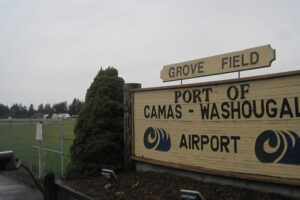When Martha Martin started researching the potential for building a performing arts and cultural center on the Washougal waterfront, she discovered that was one of the area’s historical uses.
As Martin, a Washougal resident and psychologist with a downtown Washougal practice, learned, the area — called Catalpha Grove — was used for performing arts more than 100 years ago.
“In about 1878, a couple decided to build a saloon and a hotel, and then an outdoor destination entertainment area,” Martin told Port of Camas-Washougal commissioners at their Nov. 4 meeting. “People came here by the thousands to this waterfront site right behind us. They danced, played croquet, listened to a band, had sack races, trapeze performances, greased pig races. Somebody else already thought that this was a really good place to have events and music and celebration.”
Martin and Washougal City Councilwoman and Our Bar co-owner Alex Yost are co-chairs of a 14-member steering committee that has been investigating the feasibility of having a performing arts and cultural center on the waterfront since June.
The two women and several other committee members presented the first draft of the committee’s plan at the Nov. 4 meeting.


